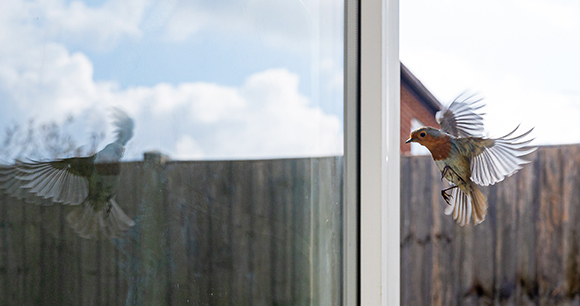Stop Window Strikes: Helping Birds Bypass the Glass
As juvenile birds fledge the nest, and hundreds of species of birds begin their annual migration to their winter habitats, this time of year presents the perfect opportunity to start protecting birds from one of the deadliest threats they face: windows strikes. Many of us have heard the sickening thud of a bird hitting a window. According to a recent estimate, at least 1.3 to 3.5 billion birds are killed in the United States each year due to collisions with window glass (Klem et al., The Wilson Journal of Ornithology, 2024). Even when birds fly away from such a collision, they often die later from concussions, internal bleeding, or other physical trauma. Almost half of these deaths occur from birds hitting windows in residential homes.

Window strikes occur both day and night. Daytime collisions occur when birds see the reflection of sky or outdoor foliage in windows and believe this reflection is additional habitat. Nighttime collisions occur when nocturnal migrants are drawn to lights inside the home, pulling them off their migratory path. In both instances, birds fail to perceive the window as a solid barrier, often flying into panes at their normal cruising speed of 20–30 mph (or more if a predator is in pursuit).
Fortunately, there are simple, cost-effective measures to reduce the chances of birds striking your home’s windows. Start by identifying danger zones, such as large picture windows, windows at right angles to each other, and windows near bird feeders. Examine your windows by going outside to see if vegetation or the sky is reflected in the panes. If so, that presents a danger that should be mitigated. Below are a number of techniques to help keep birds safely on the wing:
- Tapes: Form patterns of dots or stripes with easy-to-apply tapes affixed vertically or horizontally, no more than 2 inches apart.
- Acopian BirdSavers (Zen Wind Curtains): Favored by the Cornell Lab of Ornithology, these are made of vertical nylon cords hung on the outside of windows.
- Decals: Place decals uniformly 2 inches apart across the entire outside window surface.
- Tempera paint: Apply freehand or with stencils on the outside of windows, making patterns with spaces no more than 2 inches apart.
- Screens: Installing mosquito screens on the outside of the window is effective, as long as the screen covers the entire window.
- Opaque and patterned film: These make windows appear opaque from the outside, while still allowing those inside to see out.
The following websites offer detailed information on these options, as well as links to vendors:
External shutters, external sun shades or awnings, or internal vertical blinds kept half open are more costly options, but may also reduce energy costs. Most of these methods work equally well for commercial buildings.
Since 1970, North American wild bird populations have declined by nearly 30 percent. Reversing this troubling trend will involve preserving habitat and reducing human-caused mortality. Protecting our feathered friends from fatal window strikes is essential to that effort.
Program Terms: Terrestrial Wildlife
AWI Quarterly Terms: Feature Article
Related News
IUCN Reaffirms Long-Tailed Macaques’ Endangered Status Despite Industry Pressure
In Program: Terrestrial WildlifeThe International Union for Conservation of Nature (IUCN) today released an update to its Red List of Threatened Species. The update revealed that the long-tailed...
AWI Funds Research to Alleviate Human-Wildlife Conflicts, Animal Suffering
In Program: Terrestrial WildlifeThe Animal Welfare Institute (AWI) announced today the eight recipients of its Christine Stevens Wildlife Award who are developing humane solutions to human-wildlife conflicts and...
Refuge from Cruel Trapping Act Reintroduced to Protect Wildlife and Pets on Public Lands
In Program: Companion Animals, Terrestrial WildlifeThe Animal Welfare Institute (AWI) endorses the Refuge from Cruel Trapping Act, reintroduced today in the US House of Representatives by Rep. Jerrold Nadler (D-NY)....
Colorado Now Leads Country in Comprehensive Approach to Fighting Wildlife Trafficking
In Program: Terrestrial WildlifeToday, Colorado Gov. Jared Polis signed S.B. 25-168 into law to combat wildlife trafficking. The bipartisan legislation, which is unique among states for the number...